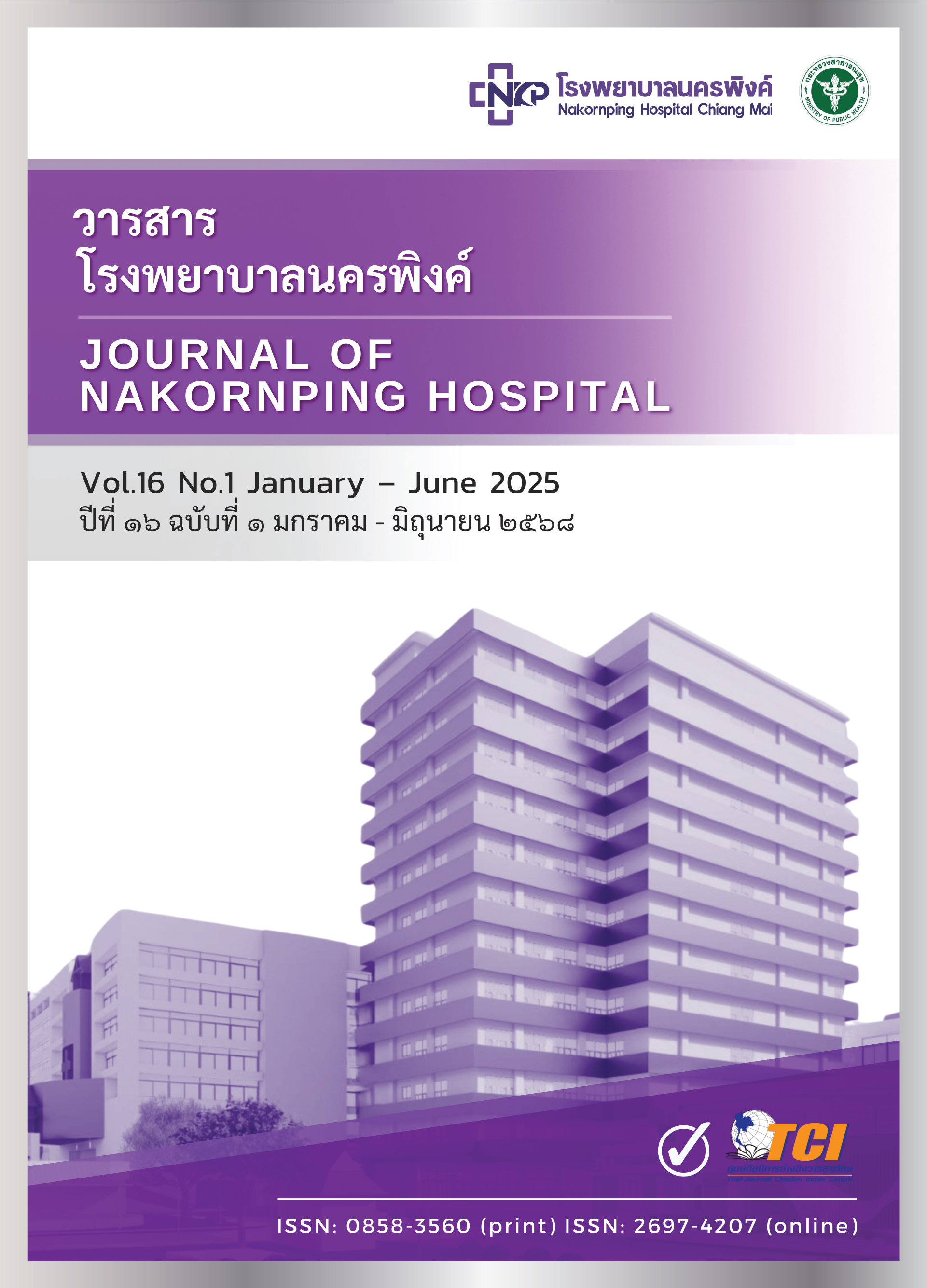ลักษณะคุณภาพชีวิตและปัจจัยสัมพันธ์ในผู้ป่วยเด็กโรคธาลัสซีเมียชนิดพึ่งพาเลือดในโรงพยาบาลนครพิงค์
คำสำคัญ:
คุณภาพชีวิต, ธาลัสซีเมียพึ่งพาเลือด, ภาวะซึมเศร้า, PEDsQL, CES-Dบทคัดย่อ
บทนำ ธาลัสซีเมียเป็นโรคเม็ดเลือดแดงแตกเรื้อรัง มีความผิดปกติในสร้างฮีโมโกลบิน ความรุนแรงแตกต่างกันตามชนิดของโรค หากเป็นชนิดรุนแรงผู้ป่วยจำเป็นต้องรับเลือดอย่างสม่ำเสมอ เพื่อลดอาการซีด ตับม้ามโต และให้เติบโตปกติ ซึ่งส่งผลกระทบต่อชีวิตประจำวันในด้านร่างกาย จิตใจ อารมณ์ และสังคม
วัตถุประสงค์ ศึกษาลักษณะคุณภาพชีวิตและปัจจัยที่เกี่ยวข้องในผู้ป่วยเด็กโรคธาลัสซีเมียชนิดพึ่งพาเลือดที่โรงพยาบาลนครพิงค์
วิธีการศึกษา การศึกษาวิจัยแบบภาคตัดขวางเชิงวิเคราะห์ (Cross-sectional analytical study) ในผู้ป่วยเด็กธาลัสซีเมียชนิดพึ่งพาเลือด อายุ 2-15 ปี พร้อมผู้ปกครองที่มารับบริการเติมเลือดแบบ One day service แผนกกุมารเวชกรรม โรงพยาบาลนครพิงค์ ระหว่างวันที่ 2-24 มีนาคม 2566 จำนวน 70 ราย โดยใช้แบบสอบถาม คุณภาพชีวิตสำหรับเด็ก Pediatric Quality of Life InventoryTM (PedsQLTM) รุ่นที่ 4.0 ฉบับภาษาไทย โดยผู้ป่วยที่อายุมากกว่า 4 ปีจะตอบแบบสอบถามเอง และหากอายุน้อยกว่า 4 ปี ผู้ปกครองจะตอบแบบสอบถามแทน และแบบคัดกรองภาวะซึมเศร้าทั้งในผู้ป่วยและผู้ปกครอง วิเคราะห์ข้อมูลด้วยสถิติเชิงพรรณนา และใช้ multivariable linear regression ในการวิเคราะห์ปัจจัยที่สัมพันธ์กับคุณภาพชีวิต
ผลการศึกษา ผู้ป่วยเด็กโรคธาลัสซีเมียชนิดพึ่งพาเลือดกลุ่มตัวอย่างพบเพศชายร้อยละ 51.43 ส่วนใหญ่อายุ 8–12 ปี พบชนิด β-thalassemia/E disease มากที่สุด (ร้อยละ 55.7) ต้องรับเลือดทุก < 4 สัปดาห์ (ร้อยละ 80) มีปริมาณเหล็กสะสมสูง ≥ 2,500 ng/ml (ร้อยละ 44.29) และรับยาขับเหล็กร้อยละ 94.29 พบว่ามีคะแนนคุณภาพชีวิตเฉลี่ยทั้ง 4 ด้านอยู่ที่ 89.24±11.84 คะแนน ซึ่งอยู่ในระดับดี ด้านสังคมมีคะแนนสูงสุด 93.43±13.15 คะแนน ด้านอารมณ์ 91.57±14.20 คะแนน ด้านร่างกาย 89.51±13.30 คะแนน และด้านโรงเรียนมีคะแนนต่ำที่สุดที่ 79.00±14.82 คะแนน พบว่ามีปัจจัยเดียวที่สัมพันธ์กับคุณภาพชีวิตอย่างมีนัยสำคัญทางสถิติ คือ ภาวะซึมเศร้า
สรุป คะแนนคุณภาพชีวิตโดยรวมอยู่ในเกณฑ์ที่สูง แต่ด้านโรงเรียนมีคะแนนคุณภาพชีวิตต่ำสุด และภาวะซึมเศร้าเป็นปัจจัยที่สัมพันธ์กับคุณภาพชีวิต การพัฒนาระบบบริการที่เติมเลือดช่วงวันหยุดลดการขาดเรียน การประเมินสุขภาพจิตในผู้ป่วยเรื้อรังและการจัดระบบการช่วยเหลือเด็กป่วยของโรงเรียนจะช่วยพัฒนาคุณภาพชีวิตได้
เอกสารอ้างอิง
Telfer P, Constantinidou G, Andreou P, Christou S, Modell B, Angastiniotis M. Quality of life in thalassemia. Ann N Y Acad Sci. 2005;1054:273-82. doi: 10.1196/annals.1345.035.
Farmakis D, Porter J, Taher A, Domenica Cappellini M, Angastiniotis M, Eleftheriou A. 2021 Thalassaemia International Federation Guidelines for the Management of Transfusion-dependent Thalassemia. Hemasphere. 2022;6(8):e732. doi: 10.1097/HS9.0000000000000732.
Cappellini MD, Farmakis D, Porter J, Taher A. Guidelines for the Management of transfusion dependent thalassemia (TDT). 4th Ed. Nicosia: Thalassemia International Federation; 2021.
Torcharus K, Charoenkhwan P, editors. Guidelines for the Management of Thalassemia. Bangkok: The Thai Society of Hematology; 2019. [In Thai]
Angelucci E. Hematopoietic stem cell transplantation in thalassemia. Hematology Am Soc Hematol Educ Program. 2010;2010:456-62. doi: 10.1182/asheducation-2010.1.456.
Karponi G, Zogas N. Gene Therapy For Beta-Thalassemia: Updated Perspectives. Appl Clin Genet. 2019;12:167-80. doi: 10.2147/TACG.S178546.
Thompson AA, Walters MC, Kwiatkowski J, Rasko JEJ, Ribeil JA, Hongeng S, et al. Gene Therapy in Patients with Transfusion-Dependent β-Thalassemia. N Engl J Med. 2018;378(16):1479-93. doi: 10.1056/NEJMoa1705342.
Taher AT, Bou-Fakhredin R, Kattamis A, Viprakasit V, Cappellini MD. Improving outcomes and quality of life for patients with transfusion-dependent β-thalassemia: recommendations for best clinical practice and the use of novel treatment strategies. Expert Rev Hematol. 2021;14(10):897-909. doi: 10.1080/17474086.2021.1977116.
Cappellini MD, Porter JB, Viprakasit V, Taher AT. A paradigm shift on beta-thalassaemia treatment: How will we manage this old disease with new therapies?. Blood Rev. 2018;32(4):300-11. doi: 10.1016/j.blre.2018.02.001.
Sritipsukho P, Wisai M, Thavorncharoensap M. Reliability and validity of the Thai version of the Pediatric Quality of Life Inventory 4.0. Qual Life Res. 2013;22(3):551-7. doi: 10.1007/s11136-012-0190-y.
Rachawat P, Pulom N. Factors Influencing Quality Of Life In Children With Thalassemia. Research and Development Health System Journal. 2022;15(1): 334-49. [In Thai]
Wongchum R, Prabsamornchai R, Thubpaen D. A Quality of Life Among Transfusion Dependent Thalassemia Patients in a Pediatric Ward, Lamphun Hospital. Journal of Nursing, Siam University. 2021;22(43):21-34. [In Thai]
Ngampraphasom P. Quality of life in Children with transfusion-dependent thalassemia at Phrae Hospital. Journal of the Phrae Hospital. 2020;28(1):12-26. [In Thai]
Duangchu S, Wongchanchailert M, Khotchawan S. Quality of Life in Children with Transfusion-Dependent Thalassemia at Songklanagarind Hospital. Songklanagarind Medical Journal. 2014;32(6):353-63. [In Thai]
Sinlapamongkolkul P, Surapolchai P. Health-Related Quality of Life in Thai Children with Thalassemia as Evaluated by PedsQL and EQ-5D-Y: A Single-Center Experience. Mediterr J Hematol Infect Dis. 2020;12(1):e2020036. doi: 10.4084/MJHID.2020.036.
Sarisuta P. Quality of Life and Prevalence of Depression among Children with Thalassemia in Panyananthaphikkhu Chonprathan Medical Center. Journal of Public Health. 2019;49(2):200-9. [In Thai]
Thavorncharoensap M, Torcharus K, Nuchprayoon I, Riewpaiboon A, Indaratna K, Ubol BO. Factors affecting health-related quality of life in Thai children with thalassemia. BMC Blood Disord. 2010;10:1. doi: 10.1186/1471-2326-10-1.
Ismail DK, El-Tagui MH, Hussein ZA, Eid MA, Aly SM. Evaluation of health-related quality of life and muscular strength in children with beta thalassemia major. Egypt J Med Hum Genet. 2018;19(4):353-7. doi: 10.1016/j.ejmhg.2018.04.005.
Yasmeen H, Hasnain S. Quality of Life of Pakistani Children with β-Thalassemia Major. Hemoglobin. 2018;42(5-6):320-5. doi: 10.1080/03630269.2018.1553183.
Tuysuz G, Tayfun F. Health-related Quality of Life and its Predictors Among Transfusion-dependent Thalassemia Patients. J Pediatr Hematol Oncol. 2017;39(5):332-6. doi: 10.1097/MPH.0000000000000790.
Shafie AA, Chhabra IK, Wong JHY, Mohammed NS, Ibrahim HM, Alias H. Health-related quality of life among children with transfusion-dependent thalassemia: A cross-sectional study in Malaysia. Health Qual Life Outcomes. 2020;18(1):141. doi: 10.1186/s12955-020-01381-5.
Boonchooduang N, Louthrenoo O, Choeyprasert W, Charoenkwan P. Health-Related Quality of Life in Adolescents with Thalassemia. Pediatr Hematol Oncol. 2015;32(5):341-8. doi: 10.3109/08880018.2015.1033795.
Ajij M, Pemde HK, Chandra J. Quality of Life of Adolescents With Transfusion-dependent Thalassemia and Their Siblings: A Cross-sectional Study. J Pediatr Hematol Oncol. 2015;37(3):200-3. doi: 10.1097/MPH.0000000000000244.
Drahos J, Boateng-Kuffour A, Calvert M, Levine L, Dongha N, Li N, et al. Health-Related Quality-of-Life Impacts Associated with Transfusion-Dependent β-Thalassemia in the USA and UK: A Qualitative Assessment. Patient. 2024;17(4): 421-39. doi: 10.1007/s40271-024-00678-7.
Venty V, Rismarini R, Puspita D, Kesuma Y, Indra RM. Depression in children with thalassemia major: prevalence and contributing factors. Paediatr Indones. 2018;58(6):263-8.
Al-Hakeim HK, Najm AH, Al-Dujaili AH, Maes M. Major Depression in Children with Transfusion-Dependent Thalassemia Is Strongly Associated with the Combined Effects of Blood Transfusion Rate, Iron Overload, and Increased Pro-inflammatory Cytokines. Neurotox Res. 2020;38(1):228-41. doi: 10.1007/s12640-020-00193-1.
Sarhan AL, Modallal S, Mahamid FA, Berte DZ. Depression symptoms and associated factors among thalassemia patients in the Palestinian Territories: a cross-sectional study. Middle East Current Psychiatry. 2022;29:1-8.
Bizri M, Koleilat R, Akiki N, Dergham R, Mihailescu AM, Bou-Fakhredin R, et al. Quality of life, mood disorders, and cognitive impairment in adults with β-thalassemia. Blood Rev. 2024;65:101181. doi: 10.1016/j.blre.2024.101181.
ดาวน์โหลด
เผยแพร่แล้ว
รูปแบบการอ้างอิง
ฉบับ
ประเภทบทความ
สัญญาอนุญาต
ลิขสิทธิ์ (c) 2025 โรงพยาบาลนครพิงค์

อนุญาตภายใต้เงื่อนไข Creative Commons Attribution-NonCommercial-NoDerivatives 4.0 International License.
บทความที่ได้รับการตีพิมพ์เป็นลิขสิทธิ์ของโรงพยาบาลนครพิงค์ จ.เชียงใหม่
ข้อความที่ปรากฏในบทความแต่ละเรื่องบทความในวารสารวิชาการและวิจัยเล่มนี้เป็นความคิดเห็นส่วนตัวของผู้เขียนแต่ละท่านไม่เกี่ยวข้องกับโรงพยาบาลนครพิงค์ และบุคลากรท่านอื่นๆในโรงพยาบาลฯ ความรับผิดชอบเกี่ยวกับบทความแต่ละเรื่องผู้เขียนจะรับผิดชอบของตนเองแต่ละท่าน



